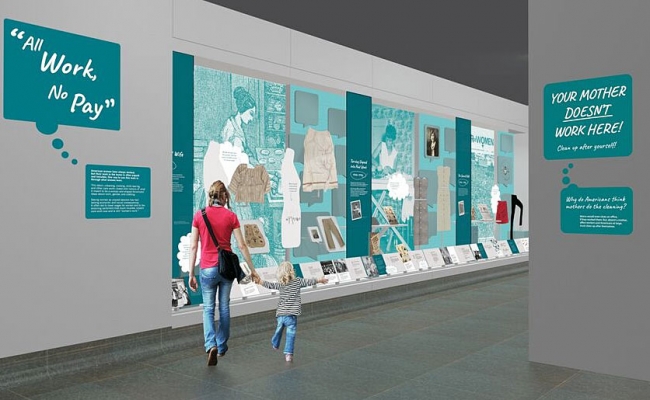“All Work, No Pay”
Women’s History Month Exhibit Focuses on Challenges of Domestic Life
March 26, 2019
Women’s History Month- which began as Women’s History Week- began in March of 1986. Since then, it has been an outlet for us to celebrate women’s success, tell their unique stories, and advocate for laws that better protect their rights. Though the lives of extraordinary female astronauts, politicians, and suffragists are often put on a pedestal and exalted by the general public, the superwoman abilities of everyday mothers and wives are often left unappreciated.
Until now.
Recently, the Women’s Invisible Labor exhibit at the National Museum of American History opened and has attracted patrons from around the DC Metropolitan area. The exhibit, titled “All Work, No Pay,” highlights the uncompensated work women do at home and the struggle to break traditional gender roles that keep women shackled to domestic life.
The exhibit begins by showing the different forms of clothing women have worn to do chores, beginning in the 1700’s. This includes the two pocket apron and short gown, which was worn by both free women and slaves. It is noted that at the time, most work was done in the home by the entire family. As women slowly entered the workforce, housekeeping was now profitable. When the women who were heads of a household left for work, another woman, known as a servant or maid, would take care of the home, children and meals for low pay.
At the turn of the century, as factory work joined mainstream popularity, masses of unmarried women took jobs in cities, working with fabrics and textiles. At this point, women were almost fully integrated into the workforce while still completing the laborious duties at home afterwards. Once the Great Depression hit in the 1930’s, even married women had to sacrifice, looking for work away from home. As mentioned in the exhibit, the Nelly Don Factory in particular was a mass producer of women’s house dresses that employed many women during the 1940’s.
From the 1950’s to the 1970’s, a widespread wave of feminism caused changes in women’s rights that normalized mothers in the workforce and called for more economic freedom. This eventually spurred the “Wages For Housework” movement which began in Italy and protested the social divisions caused by gender roles. Their concerns included unemployment benefits, parental leave, and unequal pay. Despite the efforts made by this movement and others like it, they remain underpaid compared to their male counterparts, which the exhibit displays through infographics.
One particular statistic that is often cited when discussing inequality between men and women in the workforce is the pay gap. According to Women’s Bureau, women currently make 75 cents for every dollar that a man makes. This horrendous display of gender inequality affects too many women and perpetuates the idea that women will never be granted the level of rights and independence that men have.
Exhibits like “No Work, No Pay” brings the issue of women’s rights to the forefront and begin the discussion of changes that must occur to bring us closer to a just world.












































